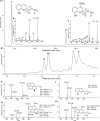Glandular quinoline-derivates protect crustacean woodlice from spider predation
- PMID: 40763796
- PMCID: PMC12324876
- DOI: 10.1098/rsif.2025.0260
Glandular quinoline-derivates protect crustacean woodlice from spider predation
Abstract
In evolutionary time, aquatic crustaceans colonized land and faced new terrestrial predators such as spiders and ants. We tested the hypothesis that the crustacean terrestrial woodlouse Porcellio scaber produces defensive metabolites that provide protection against terrestrial predators. When attacked by a predator, P. scaber expels proteinaceous secretions from its tegumental glands. Analyses of gland secretion extracts by gas chromatography-mass spectrometry and by liquid chromatography-mass spectrometry revealed four metabolites: methyl 8-hydroxy-quinoline-2-carboxylate, methyl 8-hydroxy-4-methoxy-quinoline-2-carboxylate, methyl 8-(sulfooxy)quinoline-2-carboxylate and methyl 4-methoxy-8-(sulfooxy)quinoline-2-carboxylate, the latter three being natural products not previously known. In behavioural experiments, Steatoda grossa spiders readily preyed on Tenebrio molitor beetles but avoided chemically well-defended P. scaber. When beetles were rendered chemically well-defended by topical applications of either P. scaber gland secretion extract or synthetic metabolites identified in these extracts, spiders rejected the beetles as prey. Our data support the hypothesis that P. scaber produces defensive metabolites against terrestrial predators. We show that the crustacean P. scaber, like many insects, is chemically defended against predators.
Keywords: Oniscidia; antipredator trait; chemical ecology; spider.
Conflict of interest statement
We declare we have no competing interests.
Figures


Similar articles
-
Loss of olfaction reduces caterpillar performance and increases susceptibility to a natural enemy.Elife. 2025 Aug 1;14:RP105585. doi: 10.7554/eLife.105585. Elife. 2025. PMID: 40747879 Free PMC article.
-
Relative size matters: eyespots on large insect prey deter small arthropod predators.Proc Biol Sci. 2025 May;292(2047):20250324. doi: 10.1098/rspb.2025.0324. Epub 2025 May 21. Proc Biol Sci. 2025. PMID: 40393487
-
A global assessment of large terrestrial carnivore kill rates.Biol Rev Camb Philos Soc. 2025 Feb;100(1):327-350. doi: 10.1111/brv.13143. Epub 2024 Sep 11. Biol Rev Camb Philos Soc. 2025. PMID: 39262094 Free PMC article.
-
Prey responses to direct and indirect predation risk cues reveal the importance of multiple information sources.J Anim Ecol. 2024 Dec;93(12):1983-1995. doi: 10.1111/1365-2656.14209. Epub 2024 Oct 28. J Anim Ecol. 2024. PMID: 39467075
-
The evolution of prey-attraction strategies in spiders: the interplay between foraging and predator avoidance.Oecologia. 2023 Aug;202(4):669-684. doi: 10.1007/s00442-023-05427-5. Epub 2023 Aug 4. Oecologia. 2023. PMID: 37540236 Free PMC article. Review.
References
-
- Sugiura S. 2020. Predators as drivers of insect defenses. Entomol. Sci. 23, 316–337. ( 10.1111/ens.12423) - DOI
-
- Dettner K. 2010. Chemical defense and toxins of lower terrestrial and freshwater animals. In Comprehensive natural products II (eds Mander LN, Lui H-W), pp. 387–410. Amsterdam, The Netherlands: Elsevier. ( 10.1016/B978-008045382-8.00100-3) - DOI
MeSH terms
Substances
Grants and funding
LinkOut - more resources
Full Text Sources

